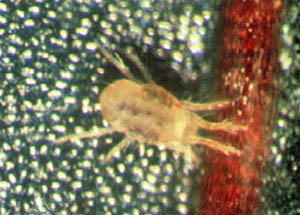Twospotted Spider Mite (Tetranychus urticae)

In the growing season, adults are about 1/7 mm long, a little larger than a period on a page. They have one oval body segment with eight legs. They are greenish-yellow with a black spot on each side of the body. Eggs are white to yellow. Reddish-orange adult females overwinter in bark cracks.
Spider mites have a very broad host range. They feed on conifers (see spruce spider mite, above), deciduous trees and shrubs, as well as herbaceous plants.
Spider mites suck leaf juices, causing minute white-to-yellow stipples to appear. When large spider mite populations feed, the stipples coalesce and leaves may turn white to yellow to grayish-brown and then die. Some plants are particularly susceptible to spider mite toxins, and even low populations may cause leaves to die.
Look for early signs of stippling with the beginning of hot summer weather. Examine the underside of damaged leaves or tap them over white paper and look for spider mites with two spots on the body. Also look for predators, such as phytoseiid mites and lady beetles, and note their relative abundance in relation to the number of mites present.
In dry, hot, sunny locations, this spider mite may produce one generation a week. Use horticultural oil or insecticidal soap sprays for low mite populations to conserve any beneficials present. When damage becomes objectionable, mite populations are high, and there are not beneficials, consider using a residual miticide spray. Reevaluate in one week.
